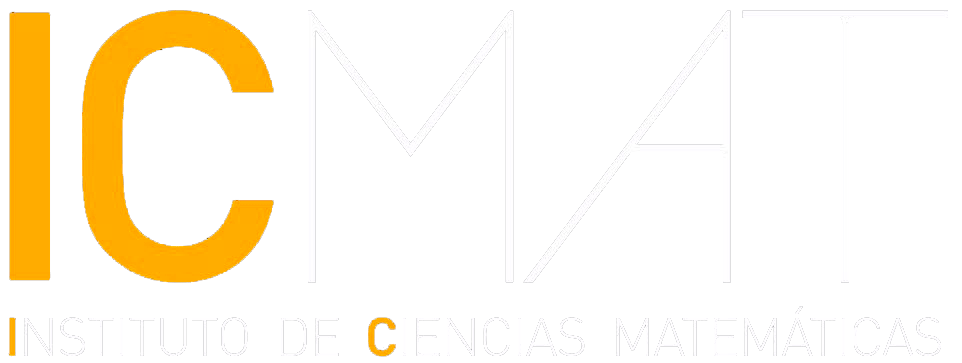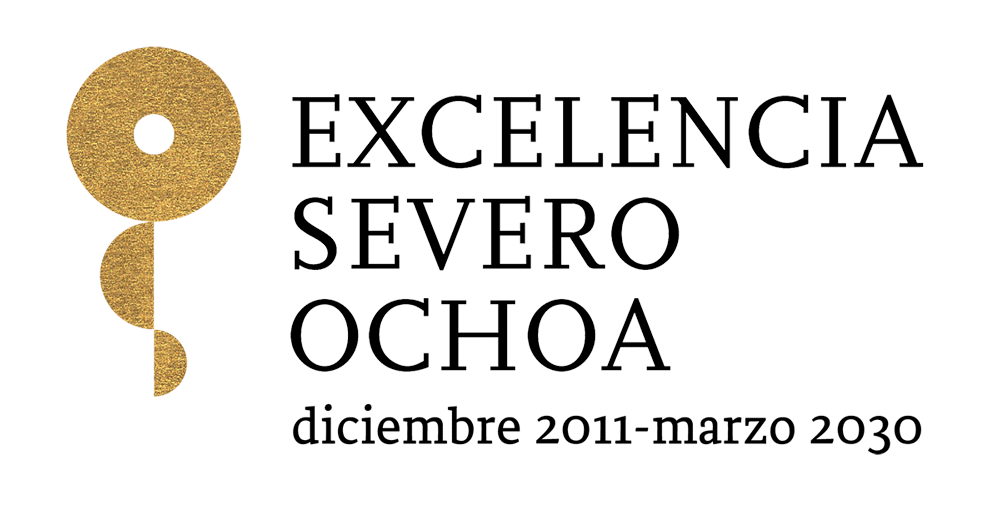Programme
Tuesday 26:14:00-14:40: Luis Álvarez Cónsul 14:40–15:10: Coffee break 15:10–15:50: Roberto Rubio 16:00-16:20: Filip Moucka |
Wednesday 27:10:00-10:40: Federico Cantero 10:40-11:00 Alfredo Llosa 11:00-11:30: Coffee break 11:30-12:10: Marina Logares 12:10–12:30: Diego Ruiz 12:30-14:00: Lunch 14:00-14:40: Adela Latorre 14:40–15:00: Rodrigo Pool 15:00–15:30: Coffee break 15:30–16:10: Yago Antolín |
Thursday 2810:00-10:40: Ignasi Mundet i Riera 10:40-11: Pablo Nicolás 11:00–11:30: Coffee break 11:30–12:10: Ana Peón 12:10–12:30: Miguel Gonzalez 12:30-14:00: Lunch 14:00-14:40: David Alfaya 14:40-15:10: Coffee break 15:10-16:00: Poster Session |
Friday 2910:00–10:40: Fernando Sancho 10:40–11:10: Coffee break 11:10–11:50: Alfonso Zamora 12:00–12:40: Carlos Tejero |
Senior talks:
David Alfaya (ICAI-ITT, Comillas Pontifical University): Isomorphisms between moduli stacks.
Abstract: We prove Torelli type theorems for moduli stacks of vector bundles with fixed determinant and for moduli stacks of principal G-bundles over a smooth complex projective curve, showing that the isomorphism classes of these stacks identify univocally the isomorphism class of the curve. Moreover, we give an explicit description of each existing isomorphism between two possibly dif-ferent moduli stacks of vector bundles.
Joint works with Indranil Biswas, Tomás Gómez and Swarnava Mukhopadhyay.
Luis Álvarez cónsul (ICMAT): Gravitating vortices and symplectic reduction by stages.
Abstract: Cosmic strings are a class of static solutions to the Einstein field equations in four-dimensional space-time, coupling gravity to superconducting vortices, that may have been formed at phase transitions as the universe cooled down shortly after the big bang. In the simplest model, gravitation is induced from a two-dimensional surface perpendicular to the strings, that are straight and infinitely long. In this talk, I will study the problem of existence and uniqueness of solutions in the so-called critical Bogomolnyi phase, when the surface is compact and orientable. We use a var-iational approach that combines methods from reduction by stages in symplectic geometry, geo-metric invariant theory in algebraic geometry, and finite-energy pluripotential theory, as recently applied to constant scalar curvature Kähler metrics. This is joint work with Mario Garcia-Fernandez, Oscar Garcia-Prada, Vamsi Pritham Pingali and Chengjian Yao (arXiv:2406.03639).
Yago Antolín (ICMAT-UCM): TBA
Federico Cantero (UAM): Khovanov homology and Steenrod operations
Abstract: Khovanov homology is an invariant of knots and links that is obtained by applying a cer-tain 2-dimensional TQFT to knot diagrams. This invariant has been refined recently by Lipshitz and Sarkar to an invariant with values in topological spectra. As a consequence, Khovanov homology becomes endowed with Steenrod operations. I will address the question of how to compute these operations. This is joint work with Aníbal Medina-Mardones (UWO).
Adela Latorre (UPM): Pseudo-Kähler nilmanifolds with non-nilpotent complex structures.
Abstract: Let M bea2n-dimensional differentiable manifold. A pseudo-Kähler structure on M is a pair (J,ω) given by a complex structure J and a symplectic form ω satisfying
ω(J·,J·) = ω(·, ·).
Then, g(·, ·) = ω(·, J·) defines a pseudo-Riemannian metric on M. Some manifolds with pseudo-Kähler structures are Kähler manifolds (for which the metric g is positive definite) and neutral Käh-ler manifolds (for which g has signature (2m,2m), being n = 2m the complex dimension of the mani-fold). The aim of this talk is to study pseudo-Kähler structures on nilmanifolds, namely, compact quotients of connected, simply connected, nilpotent Lie groups by discrete subgroups. In particular, we will focus on those 8-dimensional real nilmanifolds that admit a complex structure of non-nilpotent type. We will present their classification and then apply it to construct pseudo-Kähler structures. This will allow us to find new examples of neutral Calabi-Yau manifolds.
Ana Peón (USC): BAA branes from subregular Hodge bundles
Abstrat: The seminal work of Hausel and Hitchin provides examples of dual BBB and BAA branes on the moduli space of Higgs bundles, the latter being given by upward flows from very stable regular nilpotent C* fixed Higgs bundles. Downward flows to very stable Higgs bundles have, à priori, com-putable BBB mirrors, so a natural question to address is whether there are very stable Higg bun-dles in components other than the ones corresponding to the zero nilpotent orbit (by Laumon), and the regular nilpotent orbit (by Hausel—Hitchin). We will show that, for GL_n, the only components of Hodge bundles with very stable points are the latter and a special type of subregular nilpotent components that we call Hitchin subregular components. For the latter, we propose a mirror BBB brane and provide evidence for this statement.
Marina Logares (UCM-IMI): TBA
Ignasi Mundet i Riera (UB-CRM): Hitchin-Kobayashi correspondence for Higgs pairs with discon-nected structure group
Abstract: I will explain ongoing joint work with O. García-Prada and P. Gothen on extending the Hitchin-Kobayashi correspondence for Higgs pairs to a setting where (1) the structure group of the principal bundle is disconnected, and (2) the necessary invariant Euclidean structure on the Lie al-gebra of the maximal compact subgroup is arbitrary. I plan to explain why these extensions are useful, and the necessary new ingredients to materialize them. I will not assume the audience to be familiar with the technical details on the proof of the standard Hitchin-Kobayashi correspondence.
Roberto Rubio (UAB): Local invariants in generalized complex geometry.
Abstract: I will first review generalized complex geometry for even-dimensional manifolds and in-troduce its extension to manifolds of any dimension, known as Bn-generalized complex geometry. Then, I will focus on the case of 3-manifolds and mention the novel appearance of local invariants, which is joint work with Joan Porti.
Fernando Sancho de Salas (USAL): The Koszul complex of a supermodule.
Abstract: We give an intrinsic construction, coordinates free, of the Koszul complex of a supermod-ule and its relation with the De Rham complex and the Berezinian. We also see applications to the computation of the cohomology of twisted p-forms on a projective superspace.
Carlos Tejero (USAL): Holomorphic spectral geometry of Hermite-Einstein vector bundles on Riemann surfaces.
Abstract: We study the spectral problem for the Bochner Laplacian $\con^*\con$ of a Hermite-Einstein vector bundle bundle $E$ with connection $\nabla$ over a Riemann surface $X$. This spectral problem is analyzed in terms of the natural holomorphic structure on $E$ defined by the Cauchy-Riemann operator associated with $\nabla$. By means of an elliptic chain of Hermite-Einstein bundles obtained by twisting $E$ with the powers of the canonical bundle of $X$ we prove that there exists a certain subset of the spectrum $\sigma_{hol}(\con^*\con)$ such that the eigensections associated with $\lambda\in\sigma_{hol}(\con^*\con)$ are given by the holomorphic sections of a certain Hermite-Einstein vector bundle of the elliptic chain. For genus $p=0,\,1$ we prove that $\sigma_{hol}(\con^*\con)$ is the whole spectrum, whereas for genus $p>1$ we get a finite number of eigenvalues.
Alfonso Zamora (UPM): Motivic invariants and mirror symmetry from root data in character varieties
Abstract: We explore the computation of motivic invariants of the G-character variety of a finitely generated group, where G is an algebraic group over an algebraically closed field of characteristic zero. The G-character variety can be stratified by conjugacy classes of parabolic subgroups of G in terms of root data where each stratum is no longer a GIT quotient but a pseudo-quotient, a relaxed notion capturing the topology and behaving well with respect to motivic calculations. Dealing with these pseudo-quotient strata is further reduced by the notion of a core: it is enough to deal with polystable points with prescribed Levi type. For reductive groups of types ABCD explicit motivic formulae are provided and several mirror symmetry statements and conjectures are derived. Results are joint work with Carlos Florentino, Azizeh Nozad and Ángel González Prieto
Junior Talks
Miguel Gonzalez (ICMAT-CSIC): Very stable G-Higgs bundles with regular nilpotent Higgs field.
Abstract: The notion of a very stable Higgs bundle was introduced by Hausel and Hitchin motivated by the study of mirror symmetry aspects in the moduli space of Higgs bundles. Given an arbitrary complex semisimple Lie group G, we state a classification result for very stable G-Higgs bundles in the case that the Higgs field is (generically) regular. This is joint work with Oscar García-Prada and Tamás Hausel.
Alfredo Llosa Lazo (ICMAT-UAM): The moduli space of Calabi-Yau structures and pseudo-Kähler reduction.
Abstract: Since the seminal work of Atiyah-Bott, Kähler reduction has proven to be an extremely fruitful framework for the construction and study of moduli spaces in complex geometry. In this talk, I will explain a symplectic reduction approach to the moduli space of Calabi-Yau metrics on a compact 2n-manifold M, that is, Riemannian metrics with holonomy contained in the special unitary group SU(n). By Yau's solution of the Calabi Conjecture, this moduli space can be regarded as naturally fibering over the moduli of complex structures on M, and it is endowed with a holomorphic structure after "complexifying" the fibres via b-fields. The construction of the moduli space metric and complex structure, will naturally lead us to unexplored territory, involving pseudo-Kähler reduction by stages and Lie 2-algebra symmetries.
Filip Moucka (UAB-CTU): Cn-generalized complex geometry.
Abstract: The vector bundle TM+T^*M comes equipped with a canonical symmetric pairing, which is a fundamental object when introducing standard generalized geometry. However, there is also an equally canonical skew-symmetric pairing, which motivates the introduction of Cn-generalized ge-ometry. In this talk, I will discuss the basic features of Cn-generalized geometry with a special fo-cus on the Cn-analogue of generalized complex structures.
Pablo Nicolás (UPC-CRM): Isomorphisms and characteristic classes of singular tangent bundles.
Abstract: Singular tangent bundles have arisen as one framework to develop a calculus for manifolds with singularities. Notorious instances of this construction are the study of escape orbits in celestial mechanics and the blow-up of certain almost-complex structures in twistor spaces.
In this talk we discuss the characteristic classes and obstructions to isomorphism for these bundles. We show any $b^m$-tangent bundle can be described in terms of the standard or $b$-tangent bundle. This result is intimately related to the desingularization procedure of Guillemin, Miranda and Weitsman. We prove that the existence of an isomorphism between standard and $b$-tangent bundles is obstructed by a combinatorial gadget called the associated graph. In general, there are additional topological obstructions. We give a criterion for isomorphism when the base manifold is a sphere and, as a byproduct, conclude that the counterexample to the singular Weinstein conjecture by Fontana, Miranda, Peralta-Salas and Oms [FMMOPS24] does not depend on the topology of the $b$-tangent bundle. We conclude the talk with some remarks on the topology of edge-tangent bundles.
This talk is based on [MN24].
References:
[FMMOPS24] Josep Fontana-McNally, Eva Miranda, Cédric Oms, and Daniel Peralta-Salas. A counterexample to the singular Weinstein conjecture. Adv. Math., 458:Paper No. 109998, 2024.
[MN24] Eva Miranda and Pablo Nicolás. Which singular bundles are isomorphic?, 2024.
Rodrigo Pool (ICMAT-CSIC): Homomorphisms between mapping class groups.
Abstract: The mapping class group of a surface is the homeomorphism group of the surface up to homotopy. Apart from their intrinsic interest, mapping class groups appear in different areas of mathematics such as hyperbolic 3-manifolds, algebraic geometry and dynamics. In this talk we will introduce these groups, some of their basic properties and a classical result of Ivanov that de-scribes their automorphism group. Time permitting, we will discuss a generalization of Ivanov’s theorem that characterizes homomorphisms between mapping class groups of different surfaces.
Diego Ruiz-Cases (ICMAT-CSIC): Holomorphic structures and the Chern correspondence for bundles with non-reductive structure group.
Abstract: The aim of this talk is to report on some ongoing work to prove a Hitchin–Kobayashi correspondence for principal bundles E with non-reductive algebraic structure group. A first step (the Chern correspondence) is to identify holomorphic structures on E with unitary connections on a reduction of the structure group to a Levi subgroup plus a section of an associated bundle. This generalizes the known cases of extensions and filtrations of vector bundles (joint work with Oscar García-Prada).



